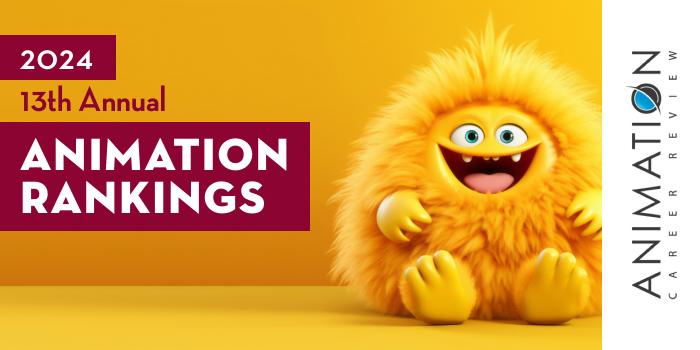
Did You Know? Clemson University helps build strong backgrounds in computer graphics and production arts to help students become successful creative professionals who enjoy their work. Learn More.

| Ranking | School | City |
|---|---|---|
| 1 | Texas A&M University | College Station |
| 2 | University of Texas at Dallas | Dallas |
| 3 | Sam Houston State University | Huntsville |
| 4 | University of the Incarnate Word | San Antonio |
Our 2024 ranking, our thirteenth annual, of the top animation school programs in Texas. For an explanation of the ranking criteria, click here.

The School of Performance, Visualization & Fine Arts (PVFA) at Texas A&M University (TAMU) is a multidisciplinary school that provides cross-disciplinary programs in music, film, theater, dance, visualization, and production. Across programs, students have access to state-of-the-art facilities and studios; courses taught by faculty who are accomplished directors, computer graphics engineers, composers, sound technologists, art historians, and dancers; and student organizations such as Women in Animation, Viz Industry Fair (VIF), and Texas Aggie Game Developers (TAGD).
Within the TAMU School of PVFA is a Visualization program that was established nearly 35 years ago. Three pathways are available for students who would like to pursue a career in animation. These include BS, MS, and MFA degrees in Visualization. The Visualization MFA is one of a few programs of its kind in the U.S. and possibly the only one in the state of Texas.
All options allow students to explore computer graphics, interaction, design, visualization, and art. Students at all levels may focus in an area of emphasis. Options for BS students include Animation and Virtual Production, Visual Computing, Media Art, Game Creation, and Interactive Design.
Students in this program will have the opportunity to work in project-based studios on courses that explore art theory, technical skills, programming, and the production pipeline. Course examples include Digital Media; Scientific and Technological Developments in Visual Arts; 2D Visualization Techniques; Visual Studies Studio 1-3; Art History; Computing for Visualization I-II; and Principles of Design 1-3. BS students may also participate in the Field Study course or sign up for the TAMU Internship Program. This supervised work experience spans 15 weeks and 600 hours. TAMU Visualization students have completed internships at animation, game, and graphic design companies. Students earn six credit hours.
TAMU Visualization MS students may focus in one of eight areas of emphasis. These include Computer Animation, Interactive Design, Virtual Reality (VR), Gaming, Augmented Reality (AR), User Experience Design, Computer Graphics, and Data Visualization. This program has both thesis (32 credit hours) and non-thesis (36 credit hours) options.
Free electives allow MS students in both options to acquire additional advanced skills in their focus area and others. Elective examples include Advanced Animation; 3D Modeling and Animation; Computer Aided Sculpting; Design Communication I-II; Form, Installation, and Environment; Physical Computing for Art & Design; and Image Synthesis.
The Visualization MFA program at TAMU focuses on technological applications and innovations, collaborative projects, and team-building. Students in this program select from eight areas of emphasis including Visual Storytelling, Visual Effects, Computer Animation, Virtual/Augmented Reality (VR/AR), Gaming, Interactive Art, User Experience Design, and Data Visualization.
Students in all emphasis areas will take courses such as Contemporary Art Studio/Seminar; Professional Study; and Professional Practice. Other courses will come from a long list of prescribed and free electives. Examples include 3D Modeling and Animation; Computer Animation; Digital image; Color Photography; Multi-Media Web Design; Physical Computing for Art & Design; and Generative Art. Students in both the MS and MFA programs also have the opportunity to complete a professional internship. Graduate internships are worth eight credits.
In addition, select Visualization graduate students will have the opportunity to participate in a Summer Industry Workshop. Students in this intensive course will work with professionals from major animation studios to produce professional-grade short films. The course takes place all day, every day, for 10 weeks.
Across all TAMU Visualization programs, students will have the opportunity to participate in the Annual Career Fair, and the Semester Away Program in Italy, Germany, and other countries.
Graduates of the Texas A&M University Visualization programs will enter the job market with a polished portfolio of their best work. Program alumni are prepared for careers across industries. However, Visualization graduates are routinely hired for positions at major studios such as Walt Disney Animation Studios, DreamWorks Animation, Pixar, Industrial Light & Magic (ILM), and Reel FX Animation.
With approximately 77,490 students, Texas A&M University the largest university in the state and one the largest in the nation. Established in 1876, TAMU is also the state’s first public institution of higher learning. With two Texas campuses, a Health Science Center, and a campus in Doha, Quatar, Texas A&M houses 16 colleges and schools that provide approximately 415 degree programs. Texas A&M University is accredited by the Southern Association of Colleges and Schools Commission on Colleges (SACSCOC).

University of Texas at Dallas (UT Dallas) is home to the Harry W. Bass Jr. School of Arts, Humanities, and Technology (Bass School). Founded in 1975, the Bass School houses the first arts and technology degree in Texas. Launched in 2002, Arts, Technology, and Emerging Communication (ATEC) at UT Dallas today consists of BA, MA, and MFA degrees. ATEC students can also earn a PhD.
For undergraduates seeking an animation degree, the ATEC BA has an Animation and Games (A&G) concentration. ATEC coursework for this option explores computer animation, motion graphics, game studies, user experience/user interface UX/UI design, and digital fabrication. Required A&G courses include Computer Animation; Game Design; Modeling and Texturing; Rigging; Lighting and Composition; and Level Design.
A&G students will also complete 30 semester credit hours of required electives. Examples include Motion Capture Animation; Animation Studies; Game Production Lab; Virtual Environments; Animation Lab; Procedural Animation; and Project Management for ATEC.
MA and PhD students may focus their studies and research in animation, science and technology, games, or other areas. ATEC MFA students may specialize in Animation or Creative Practice. All graduate level programs provide advanced study in computer-based arts, interactive media, technology, digital media, and professional practices.
Other ATEC program highlights include guest speakers from major studios such as Disney, Pixar, and DreamWorks; applied and experimental research in collaboration with instructors in varying areas of expertise; seminars and lectures presented by industry professionals; and portfolio and project-based exercises.
ATEC students have access to the following Bass School research labs and creative practice studios: 3D Studio; ArtSciLab; Creative Automata Lab; Cultural Science Lab; Emerging Gizmology Lab; Fashioning Circuits; LabSynthE; Narrative Systems Research Lab; Public Interactives Research Lab (PIRL); SP&CE Media; and The Studio for Mediating Play.
Students focusing in animation also have access to the ATEC Animation Lab, where they can participate in a simulated animated studio experience (SASE). Over two semesters, a crew of 40 SASE students will write, design, direct, and produce a two-minute CG animated short film. Examples of past productions include Bad Timing (2022), Octo Ninja (2021), Night Shift (2020), and Stargazer (2019).
Graduates of the ATEC programs at UT Dallas are prepared to pursue careers across industries and in areas such as 3D computer animation, film and television, games, modeling and simulation, virtual environments, and medical and scientific visualization. A variety of major companies and studios have hired ATEC alumni. Examples include Disney, Blizzard Entertainment, Cisco Systems, Texas Instruments, Gearbox Software, AT&T Foundry, id Software, JP Morgan Chase, and 900lbs of Creative.
University of Texas at Dallas opened in the 1960s as the Graduate Research Center of the Southwest. Established by the owners of Texas Instruments, UT Dallas is an official member of the University of Texas System, and a Carnegie R1 Doctoral Institution. The school serves more than 31,000 students enrolled in more than 140 degree programs across seven schools. University of Texas at Dallas is accredited by the Southern Association of Colleges and Schools Commission on Colleges (SACSCOC).

Sam Houston State University (SHSU) houses the College of Fine Arts and Mass Communication, home to the Department of Art. Within the Department is an Animation program that explores storyboarding, 2D and 3D animation, character design, 3D modeling/rigging/texturing, lighting, and rendering. Students in this program also benefit from interactions with guest speakers, workshops, and portfolio reviews by active professionals in the industry.
Leading to BFA, the Animation program also provides access to SHSU SIGGRAPH—a self-governed student-run organization that highlights on-campus exhibitions, student-led workshops, and creating animations and other digital art.
Course examples for this 120 credit hour program include The History of Animation; Film Appreciation; Animation Concepts and Techniques; 2D Computer Animation; Experimental Animation; Drawing I and II; Character Animation; Photographic Concepts; Shading, Lighting, and Rendering; Advanced 3D Animation; Web Site Development; Visual Computing; and Animation Preproduction. Electives allow students to focus in additional areas in the arts.
All Department of Art students will also take several Workshop in Art Studio and History (W.A.S.H.) courses including W.A.S.H. 2D, W.A.S.H. 3D, and W.A.S.H. Lecture. The Animation program culminates with the Animation Portfolio course.
Graduates of the Animation BFA program at Sam Houston State University go on to pursue careers in areas such as animation, film, game design, advertising, marketing, and multimedia. Program alumni work at places such as Zynga, EA Mobile, Kiloo Games, Perkins+Will, Stoic Studio, and Jacobs Visual Media Group. Some Animation alumni have launched their own studios or freelance businesses, while others are educators in the Texas public school system.
Graduates of the SHSU Department of Art have also been accepted into graduate programs at top universities and art and design colleges such as Savannah College of Art and Design (SCAD), University of Texas Dallas (UT Dallas), Florida State University (FSU), Texas A&M, and Southern Methodist University (SMU).
Sam Houston State University was founded in 1879 as the Sam Houston Normal Institute. The school serves approximately 21,500 students enrolled in 90 bachelor's degree programs, 55 master’s degree programs, and 10 doctoral programs, including America’s first PhD in Forensic Science. Programs at SHSU are housed across eight colleges. Sam Houston State University is accredited by the Southern Association of Colleges and Schools Commission on Colleges (SACSCOC).

The College of Humanities, Arts and Social Sciences at University of the Incarnate Word (UIW) is home to the School of Media and Design, which houses the Department of 3D Animation and Design. Within the department is the 3D Animation and Game Design (ANGD) program. Leading to a BFA, this pathway has specializations in Animation, Modeling, Programming, and Production Management. An ANGD minor is also available with options in Programming for Games and Production Management.
Across all specializations, students benefit from courses taught by professionals working in all areas of the 3D Animation and Game Industry; small class sizes; annual on-campus presentations led by game and film industry professionals; and the opportunity to complete a professional internship.
Course examples for the UIW ANGD BFA program include Visual Narrative Conventions; Animation I: Advanced Body Mechanics; Performance for Animators; History of Animation; Animation II: Animation for Games; Previsualization and Storytelling; Technical Direction; Animation III: Advanced Pantomime Acting; Organic Modeling; Animation Industry Seminar; Animation IV: Performance Animation; Motion Capture for Animators; and Business of Animation and Game Design.
ANGD BFA students will spend the final year of program working in teams to conceive, design, produce, and submit a final animated film or game for festival consideration. This team project takes place across two courses—Senior Thesis Production I-II. In addition, students will create a professional portfolio on their own during the Senior Portfolio course.
Graduates of the 3D ANGD BFA program at University of the Incarnate Word have established successful careers in animation for film, forensic animation, animation for television, VFX animation, art direction, animation in game production and design, multimedia animation, advertising animation, and animation for information technology. Program alumni have held positions at Sony, Booz Allen Hamilton, Weta FX, Naughty Dog, BioWare, Infinity Ward (the original studio behind the Call of Duty franchise), and the Los Alamos National Laboratory.
Serving approximately 9,190 students, University of the Incarnate Word is the largest Catholic University in Texas and the fourth largest private university in the state. Founded in 1881 by the Sisters of Charity of the Incarnate Word, the school has campuses in San Antonio, Texas and across the state; Mexico City and Irapuato, Guanajuato, Mexico; and Strasbourg, France. More than 120 programs are provided across 11 colleges and schools. University of the Incarnate Word is accredited by the Southern Association of Colleges and Schools Commission on Colleges (SACSCOC)